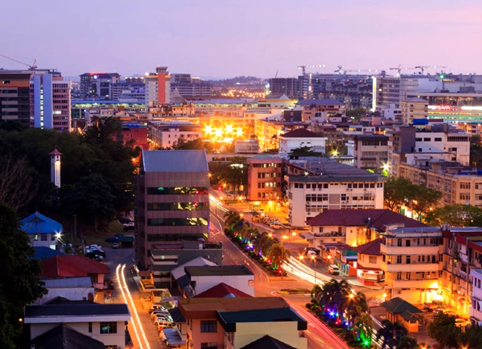With the new year approaching, now is a good time as any to identify what industry experts predict will happen in 2018. For Malaysia, 2018 is shaping up to be the year for Malaysia to shine as one of the fastest growing economies in the Asean region.
In its 2018 outlook report by the research arm of Public Investment Bank Bhd (PublicInvest Research), Malaysia might be right on track to become the second fastest growing economy in Asean - trailing right behind the Philippines.
The report guided that in 2018, Malaysia would be growing from a position of strength with ample growth potential given its average growth of 6.3 percent in the last 36 years.
"Not only is its growth rate enviable, but its ability to maintain the speed of growth is another factor that deserves credit" it said.
This growth trajectory would likely be driven by domestic demand as the research arm projected domestic demand and private consumption to grow at 5.4 and 6.4 percent respectively. Based on this, PublicInvest Research expected Malaysia's gross domestic product (GDP) to grow at 5.2 percent - conservatively within the Ministry of Finance's (MoF) projection of 5.0 to 5.5 percent.
Similarly, AmInvestment Bank Bhd (AmInvestment Bank) has also announced that they expect Malaysia's 2018 GDP to fall in line with MoF's project at 5.5 percent.
"With our 2018 GDP outlook at 5.5 percent, we believe that the quarterly GDP growth should bottom around 1Q2019 before it starts picking up as the base effect fizzles out while the overall economic activity continued to be supported by domestic demand and exports" concluded the bank.
While both forecasts are lower than the forecast GDP growth 5.8 percent for 2017, PublicInvest Research opined that 2018 conditions would still be good enough to warrant continued investment in the Bursa Malaysia.
"Foreign investors may be less of a factor in the coming year, but that may be inconsequential given the ample domestic liquidity present" said the research arm.
For specific industries, PublicInvest Research retained its overweight view on the oil and gas (O&G) and constructions sectors due to the on-going positive news flow of upcoming ventures and projects, and probable earnings uplifts.
Additionally, it pegged an ‘overweight' call on the manufacturing sector as it is expected to see a surge in demand within the industry on the account of the strong global trade.
"We also suggest selective exposure into the banking sector as we see valuation to remain attractive at current levels. We think the sector is primed for long-overdue run post-MFRS9 clarity come January 1, 2018" added the research arm.
Ringgit watch Meanwhile, the ringgit is expected to continue on with its steady growth, forecasted to be one of the fastest growing currency in the Asean region next year as Malaysia continues to gain support from advancement and stability in oil prices, steady current account surpluses and the receding political risks that will emerge after the 14th General Elections (GE14) has concluded.
Earlier in the year, the ringgit saw rapid recovery from its historic low of 4.48 against the US dollar to its present circa 4.10 levels.
"Based on our analysis, we think that the ringgit should be valued at RM3.75 to RM4.00 per US dollar - which is our long-term target.
"In the short-term, however, in 2018, we expect the Ringgit to average at RM4.00 to RM4.10 per US dollar against the 2017 average of RM4.33 per dollar" guided PublicInvest Research.
On the other hand, AmInvestment Bank stated in a separate Global Currency Outlook report that their analysis showed the ringgit with a fair value of 3.95 against the US dollar while the real effective exchange rate presented a fair value of 3.76.
"There is still plenty of room for this laggard currency to gain momentum" it said.
Expecting the ringgit to trade at 3.98 by the end-2018, the bank's forecasted average for the ringgit against the US dollar is 4.12 - a substantial improvement from its forecasted average of 4.30 in 2017.
Additionally, volatility of the ringgit has also been receding noticeably to 0.17 percent daily in 2017 from 0.59 percent daily in 2016.
PublicInvest Research expects this trend to continue on in 2018 - diminishing the need for Bank Negara Malaysia (BNM) to intervene.
Nevertheless, if the need arises, the research arm opined that the central bank would have no trouble to combat swings in the ringgit due to their ample arsenal of foreign reserves.
GE14 to stage relief for local equity market With the highly anticipated 14th General Elections (GE14) on the table next year, 2018 will definitely be a year to remember as it would either be the year where Barisan Nasional (BN) continues to defend its status as one of the longest ruling coalitions in the democratic world, or the year where we see a change in our ruling coalition.
Currently, the general consensus is that another BN win is on the cards but some staunch believers are of the opinion that there is very real possibility that the development of our GE14 may very well follow in the footsteps of the shock results of the 2016 US presidential elections.
If Pakatan does end up wining GE14, it will be uncharted territory as to how the equity market may react and players will have to tread carefully as they navigate through the new unfamiliar waters.
One thing for certain, however, is that if BN does continue its rule, analysts are confident that local equity market may stage another ‘relief rally' post wrap up of the elections.
In a strategy report, MIDF Amanah Investment Bank Bhd (MIDF Research) guided that they are expecting the local equity market to exhibit a similar behaviour of recovery post GE14 as it had after the conclusion of GE13.
Explaining this expectation, the research arm pointed out that the FBM KLCI has been recently underperforming against its emerging Asean peers just as it did during the pre-GE13 months where the local market was clearly perturbed due to the uncertainties of the GE13 results.
However, once results were out with the BN federal government clinging onto power at 60 per cent of 222 parliament seats, the local equity market breathed a sigh of relief by staging a ‘relief rally' where the FBM KLCI posted record high numbers on the following Monday after GE13.
"The local bourse surged 3.38 per cent to close at 1,752 points on post-election Monday. Furthermore, foreign investors loaded up RM1.43 billion net of Malaysian equity on the Monday after the election which has never been surpassed ever since.
"Despite the benchmark experiencing some pullbacks after the election where it retreated to circa 1,730 levels on the back of persistent foreign selling, pursuant to US Fed Chair Ben Bernanke's previous quantitative easing taper statement, the FBM KLCI got back on track, posting an annual gain of 11 per cent with a total annual foreign net inflow of RM3.03b in 2013" reported the research arm.
Explaining this phenomenon, the research arm asserted that the familiarity and predictability of a BN government was the reason why investors were given a sense of relief and allowed the local equity market to outperform its emerging Asean peers.
"Therefore, it is highly likely that the FBM KLCI will once again show a reversal of trend and outperform its regional peers if the federal incumbent were to remain in power post GE14" they reasoned.
With expectations that BN will continue to cling onto power, MIDF Research has reiterated its FBM KLCI 2017 year-end target of 1,830 points which equates to PER17 of 17.1 fold and +1.1 SD.
"Likewise, we reaffirm our FBM KLCI 2018 year-end target of 1,900 which is equivalent to PER18 of 16.7 fold and +0.9SD" they added.

.jpeg)


.png)





.jpeg)

